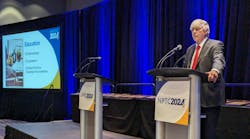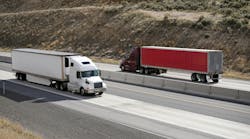FORT WORTH, TX. The F-150 pickup is being “re-invented” in the words of Ford Motor Co. (NYSE: F) executives for the 2011 model year with four new engines designed to improve on fuel economy compared to its predecessors, while boosting horsepower and torque as well.
“All of you know we’ve been on a journey for the last five years to be the leader in fuel economy with every vehicle we bring to market, and we’re putting our money where our mouth is,” said Frank Davis, Ford’s executive director of North American product, here during an F-150 ride and drive event for journalists at Texas Motor Speedway.
He said Ford plans to introduce 60 new powertrains globally by 2013, with 30 of them in North America alone. For 2011, four of them are being tailored specifically to the F-150.
The first is a 6.2-liter gasoline V8 – based off engines available on the larger F-Series SuperDuty model –offering 411 hp. and 434 lbs.-ft of torque, which is exclusive to the premium F-150 trim levels Lariat, Platinum, and King Ranch models. Next is a 5.0-liter V8 cranking out 360 hp. and 380 lbs.-ft of torque; an engine that’s also 70 lbs. lighter than the model it replaces.
Yet the key test of Ford’s vision revolves around the base engines for the F-150s “entry level” XL, STX, and XLT models – a standard 3.7-liter V6 with twin independent variable camshaft timing (Ti-VCT) generating an estimated 302 hp. and 278 lbs.-ft. of torque, along with an optional twin-turbocharged 3.5-liter Ti-VCT V6 “EcoBoost” engine, cranking out 365 hp. and 420 lbs.-ft of torque while delivering 20% better fuel economy than the previous 4.2-liter V6 it replaces.
The big gamble for Ford in the F-150 pickup segment revolves around the “EcoBoost” model; a base engine platform the company expects will be available in 90% of its North American product by 2013 and account for projected sales of 1.5 million units globally.
Jim Mazuchowski, Ford’s V6 engines program manager, told Fleet Owner the EcoBoost is designed to put a V6 engine in place of a V8, with a V8’s performance yet a V6’s fuel economy profile. “We’re trying to deliver the best of both world’s here; more power yet better fuel economy as well,” he explained.
For example, he noted both of the new V6 platforms boast vastly improved performance versus the 4.2-liter V6 they replace. The 3.7 liter offers 100 more hp. and 24 additional lbs.-ft. of torque, while the 3.5-liter EcoBoost generates 163 more hp. and 168 added lbs.-ft. of torque.
That, in turn, improves the towing and payload carrying capability of the F-150, Mazuchowski said. In the EcoBoost’s case, it boosts the F-150’s tow rating to 11,300 lbs, with a payload rating of 3,060 lbs.
“The tough part is convincing customers of these capabilities,” Mazuchowski said. “But we’ve done four years of engineering work on these engines, testing them in minus-40 to over 100 deg. F, while accumulating 1.6 million mi. of equivalent customer use.”
The key to achieving fuel economy and performance gains simultaneously revolves around several new technologies, he noted. First, Ti-VCT’s precise and variable control of the intake and exhaust camshafts optimizes performance and fuel economy, while new “piston squirters” enable faster engine oil warm-up, reducing cold start friction and thus further improving fuel economy
Then there’s electronic power assisted steering or “EPAS” which Mazuchowski said helps improve the F-150’s fuel economy by 3 to 4%.
The focus on fuel economy matched with greater capability in the lighter F-150 segment of the pickup market is critical, especially as commercial customers are starting shift down in vehicle class in search of lower overall vehicle cost, Doug Scott, Ford’s manager of truck group marketing, told Fleet Owner.
“Right now, about 16% of F-150 owners are commercial customers and that’s moving towards 20% in this segment,” he said. “About 10 to 15% of them are F-Series SuperDuty owners moving down to get just as capable a truck but at a lower cost.”
That’s in no small part due to 2010 emissions regulations for diesel engines. Ford’s new Power Stroke 6.7L diesel V-8, for example, adds $7,835 to the base price of a SuperDuty model, in part to cover the cost of new selective catalytic reduction (SCR) technology alongside diesel particulate filters (DPFs).
By contrast, Scott said Ford’s F-150 XLT crew cab 2011 model costs $450 less than the 2010 model, despite the introduction of its new gasoline-powered engines.
He added that this event is one of seven Ford is planning over the next five months in major cities across the U.S. before the F-150 launch. Scott noted the company plans to bring in at least 1,000 Ford owners per day over the several day stretches of these events, hoping to get 20,000 current Ford customers behind the wheel of the new F-150 before it rolls off the production line.


